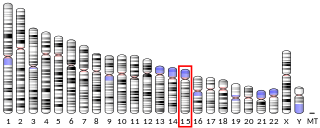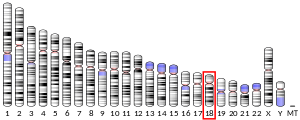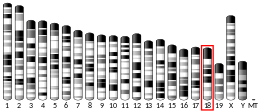
Membrane-bound transcription factor site-1 protease, or site-1 protease (S1P) for short, also known as subtilisin/kexin-isozyme 1 (SKI-1), is an enzyme that in humans is encoded by the MBTPS1 gene. S1P cleaves the endoplasmic reticulum loop of sterol regulatory element-binding protein (SREBP) transcription factors.

Cathepsin W is a protein that in humans is encoded by the CTSW gene.

Thioredoxin domain-containing protein 5 is a protein that in humans is encoded by the TXNDC5 gene.

Diacylglycerol kinase beta is an enzyme that in humans is encoded by the DGKB gene.

Tyrosine-protein phosphatase non-receptor type 21 is an enzyme that in humans is encoded by the PTPN21 gene.

Calpain-6 is a protein in humans that is encoded by the CAPN6 gene.

Junctophilin 4 is a protein in humans that is encoded by the JPH4 gene.

Motile sperm domain containing 2 is a protein that in humans is encoded by the MOSPD2 gene. It is an endoplasmic reticulum–resident protein involved in membrane contact site formation. Its domain homologous to Major Sperm Protein is very similar to VAPA/VAPB, so it has been described as the third human member of the VAP protein family.

MyoD family inhibitor domain containing is a protein that in humans is encoded by the MDFIC gene.

SRP receptor alpha subunit is a protein that in humans is encoded by the SRPRA gene.

Post-GPI attachment to proteins 1 is a protein that in humans is encoded by the PGAP1 gene.

Scavenger receptor cysteine rich family member with 4 domains is a protein that in humans is encoded by the SSC4D gene.

LIM homeobox 9 is a protein that in humans is encoded by the LHX9 gene.

Cysteine rich secretory protein LCCL domain containing 1 is a protein that in humans is encoded by the CRISPLD1 gene.

Collagen beta(1-O)galactosyltransferase 1 is a protein that in humans is encoded by the COLGALT1 gene.

Ring finger protein 103 is a protein that in humans is encoded by the RNF103 gene.

3-hydroxyacyl-CoA dehydratase 2 is a protein that in humans is encoded by the HACD2 gene.

SCAPER is a gene located on the long arm of chromosome 15 (15q24.3). It was first identified in 2007.

GRAM domain-containing 2A protein is a protein encoded by the GRAMD2A gene. Like GRAMD2B, the protein consists of a GRAM domain and a transmembrane domain that anchors it to the endoplasmic reticulum.

GRAM domain-containing 2B protein, also known as NS3TP2 and HCV NS3-transactivated protein 2 is a protein encoded by the GRAMD2B gene.

















